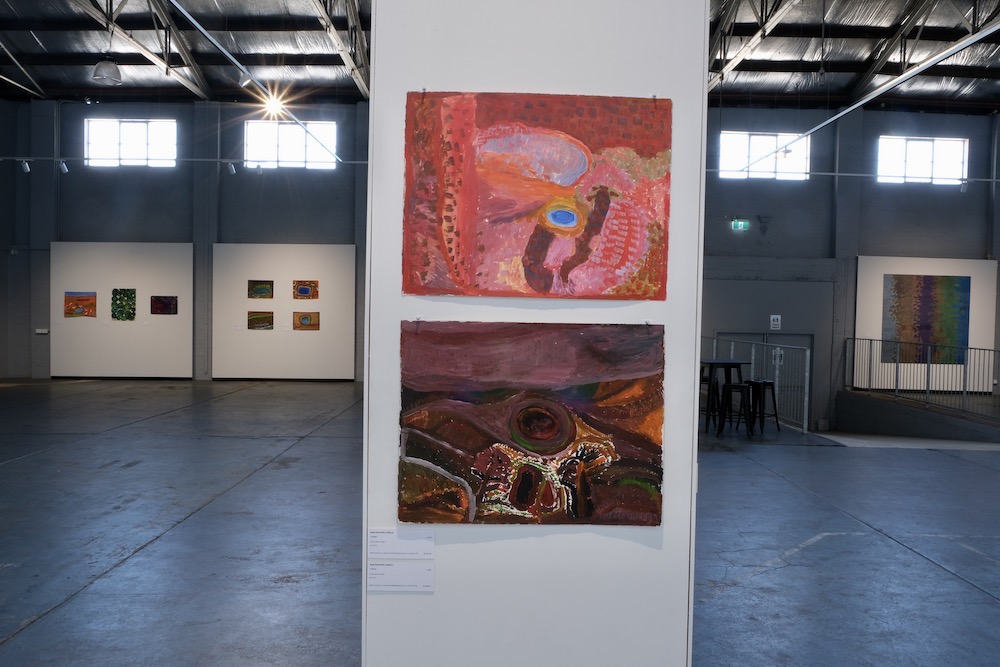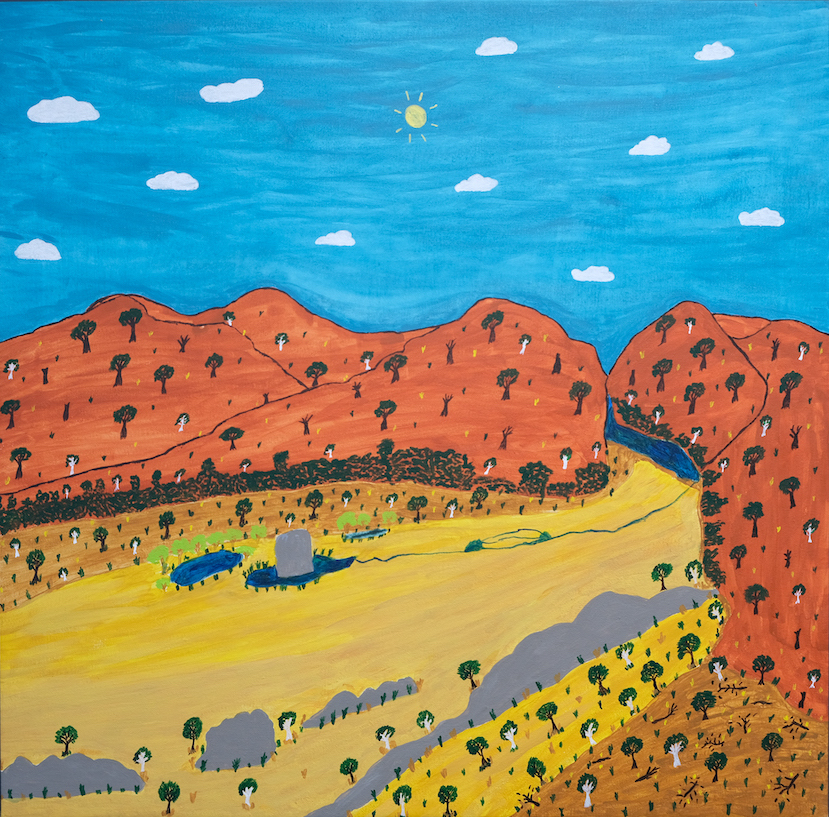Inside West Perth’s Holmes à Court Gallery Jaimi Wright is transported to Fitzroy Crossing’s Mangkaja arts centre by an exhibition that recognises the endurance of First Nations artists on Bunuba Muwayi Country.
Celebrating 30 years of creative refuge
6 September 2022
- Reading time • 6 minutesVisual Art
More like this
- A walk with Tina Stefanou
- A blaze of glorious people
- Diving into the gothic world of Erin Coates
‘Mangkaja 30 Years Strong’, various artists curated by Lynley Nargoodah and Laetitia Wilson ·
Holmes à Court Gallery @ no. 10 ·
At the heart of exhibition “Mangjaka 30 Years Strong” is the word mangkaja.
Mangkaja is a Walmajarri word meaning a wet weather shelter made by the Walmajarri people to protect themselves during the wet season in the Great Sandy Desert.
Emerging in the early 1990s, against a background of colonial upheaval and mistreatment, Fitzroy Crossing’s Mangkaja Arts Resource Agency has flourished as a sanctuary of creative freedom and diversity for First Nations artists on Bunuba Muwayi Country.
Co-curated by Lynley Marlingia Nargoodah (Mangkaja ARA) and Laetitia Wilson (Holmes à Court Gallery), “Mangkaja 30 Years Strong” celebrates not only the collective’s 30th anniversary but its role as a place of refuge, of shelter.
Featuring works from the 1990s to today by 25 Mangkaja artists, drawn from both the Janet Holmes à Court Collection and the Mangkaja Arts Resource Agency, “Mangjaka 30 Years Strong” recognises the endurance of the Fitzroy region’s First Nations peoples, revelling in the variety and history of connections to country.
What impressed me upon my first encounter with the exhibition at Holmes à Court Gallery no. 10 was the sheer variety of distinctive styles that emerged from one group of artists. From paper to canvas, abstract to figurative, “Mangkaja 30 Years Strong” offers an engaging array of depictions of country.
In Tjutjarti Trees (2017), Wangkajunga woman Lisa Uhl uses segmented blocks of acrylic paint on canvas to form the depth of a tree line. Bright purple, blue, green, red, and black sit distinct from green lines with loops at the tops of each, resting against a curved horizon. Uhl deftly conjures the stark beauty of country in this abstract work.

In an untitled work from 1991, comprised of two pieces in acrylic on paper, fellow Wangkajunga woman Nada Rawlins Tjigila also chooses abstract shapes, but instead uses dark, rolling colours to depict country from two different perspectives. The first piece has a dark mauve stormy skyline set behind rocks nestled together in the foreground, and bright colours like water or magic that trickle between them. The second appears as an aerial perspective; a vivid blue body of water sits amid dark organic forms, which speak of natural power and presence.

Goodiyandi man David Street takes a more literal approach to rendering country in his untitled 2018 work, a landscape that opens into a section of the Fitzroy Valley. In acrylic on canvas, Street presents a bright and welcoming view of the valley, the clouds and trees below evenly spaced between the blue, earthy red, and sandy yellow of the sky, background and foreground. Street’s country is not so much a place as the feeling of home brought to the medium.
However, two works by Walmajarri artists hung on either side of a doorway – Dorothy Forrest Tjikilim’s untitled 2022 work in acrylic on canvas and co-curator Lynley Marlingia Nargoodah’s Seed Collecting – Seven Seasons (2022), in acrylic on polycarbonate, – stood out for me.
Each uses organic lines with startlingly different effects. Tjikilim’s work is a sensation of pastel colours and energy, packed with different shades of squiggles dancing to the edges of the canvas around a pronounced diamond shape. The effect is joyous and infectious.
Nargoodah’s work is similarly packed with tension, depicting the transition between seasons as told by thousands of drawn coils that gradually shift between colours. The piece spills over with life, so much that looking at it too long made me uneasy and yet awestruck, like looking into the vastness of the ocean or the sky.
Within the Holmes à Court Gallery, “Mangkaja 30 Years Strong” forms a connection with the Mangkaja collective, which transcends time and creates a sanctuary of remembrance, creativity and celebration.
Be sure to give this exhibition a view and expect to be transported.
“Mangkaja 30 Years Strong” continues at Holmes à Court Gallery until 8 October 2022.
Pictured top: Dorothy Tjikilim Forrest, ‘Untitled’, 2022, copyright of Mangkaja Arts Resource Agency
Like what you're reading? Support Seesaw.






